Financial Accounting Report: Client Cases and Analysis
VerifiedAdded on 2023/02/07
|23
|3722
|28
Report
AI Summary
This report provides a comprehensive analysis of financial accounting principles and practices. It begins with an introduction to financial accounting, defining its role in business and outlining key financial statements such as the profit and loss account, balance sheet, and cash flow statement. The report then delves into the double-entry system, accrual basis of accounting, and accounting rules and regulations. It includes detailed case studies of various clients, demonstrating the application of accounting principles through double-entry recording, trial balances, and the preparation of financial statements like profit and loss accounts and statements of financial position. The report also covers ledger control accounts and the reconciliation process. Furthermore, it explores accounting concepts such as consistency and prudence, providing a well-rounded understanding of financial accounting for business operations. The report is a valuable resource for students seeking to understand and apply financial accounting principles.

Financial Accounting
Paraphrase This Document
Need a fresh take? Get an instant paraphrase of this document with our AI Paraphraser
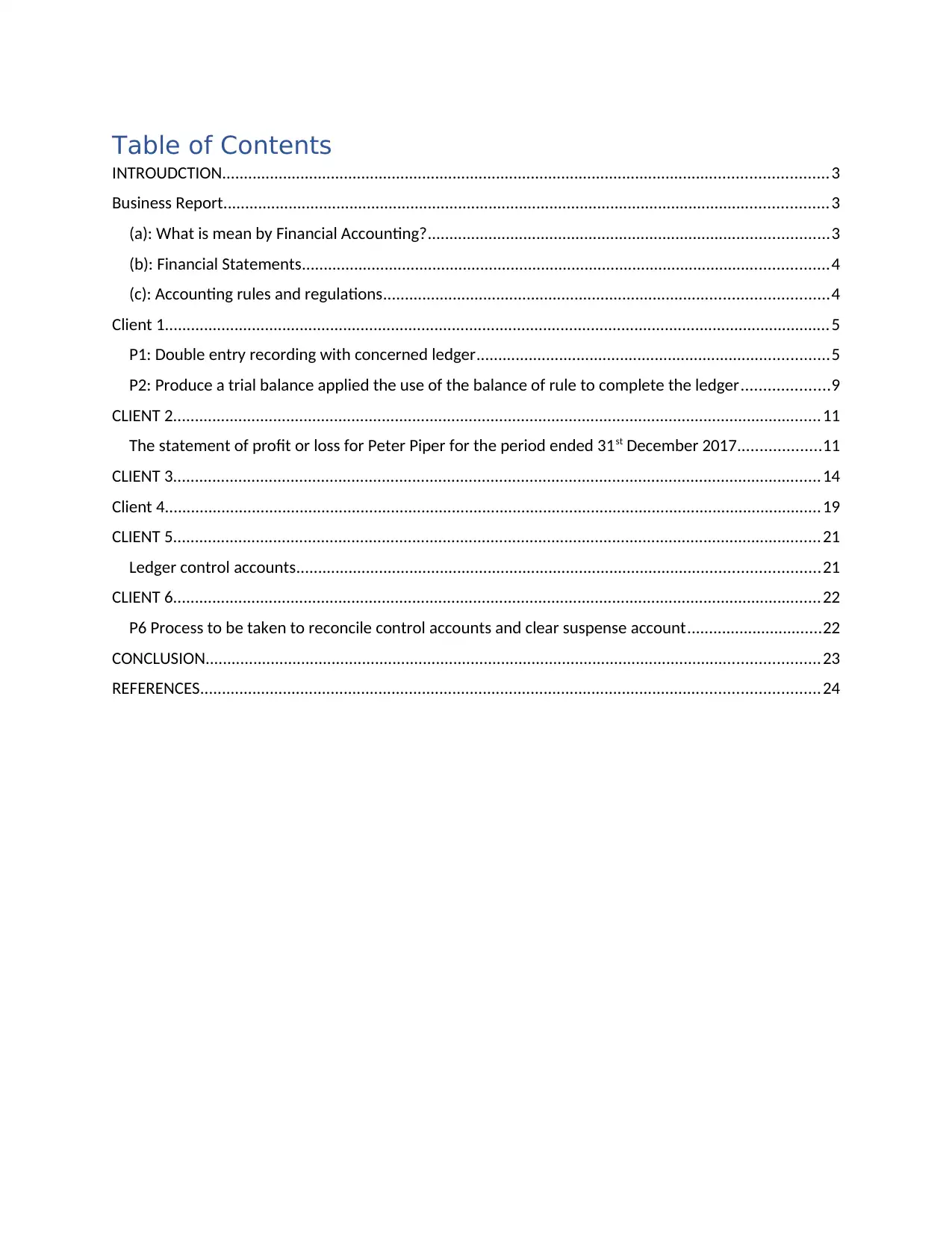
Table of Contents
INTROUDCTION...........................................................................................................................................3
Business Report...........................................................................................................................................3
(a): What is mean by Financial Accounting?............................................................................................3
(b): Financial Statements.........................................................................................................................4
(c): Accounting rules and regulations......................................................................................................4
Client 1.........................................................................................................................................................5
P1: Double entry recording with concerned ledger.................................................................................5
P2: Produce a trial balance applied the use of the balance of rule to complete the ledger....................9
CLIENT 2.....................................................................................................................................................11
The statement of profit or loss for Peter Piper for the period ended 31st December 2017...................11
CLIENT 3.....................................................................................................................................................14
Client 4.......................................................................................................................................................19
CLIENT 5.....................................................................................................................................................21
Ledger control accounts........................................................................................................................21
CLIENT 6.....................................................................................................................................................22
P6 Process to be taken to reconcile control accounts and clear suspense account...............................22
CONCLUSION.............................................................................................................................................23
REFERENCES..............................................................................................................................................24
INTROUDCTION...........................................................................................................................................3
Business Report...........................................................................................................................................3
(a): What is mean by Financial Accounting?............................................................................................3
(b): Financial Statements.........................................................................................................................4
(c): Accounting rules and regulations......................................................................................................4
Client 1.........................................................................................................................................................5
P1: Double entry recording with concerned ledger.................................................................................5
P2: Produce a trial balance applied the use of the balance of rule to complete the ledger....................9
CLIENT 2.....................................................................................................................................................11
The statement of profit or loss for Peter Piper for the period ended 31st December 2017...................11
CLIENT 3.....................................................................................................................................................14
Client 4.......................................................................................................................................................19
CLIENT 5.....................................................................................................................................................21
Ledger control accounts........................................................................................................................21
CLIENT 6.....................................................................................................................................................22
P6 Process to be taken to reconcile control accounts and clear suspense account...............................22
CONCLUSION.............................................................................................................................................23
REFERENCES..............................................................................................................................................24
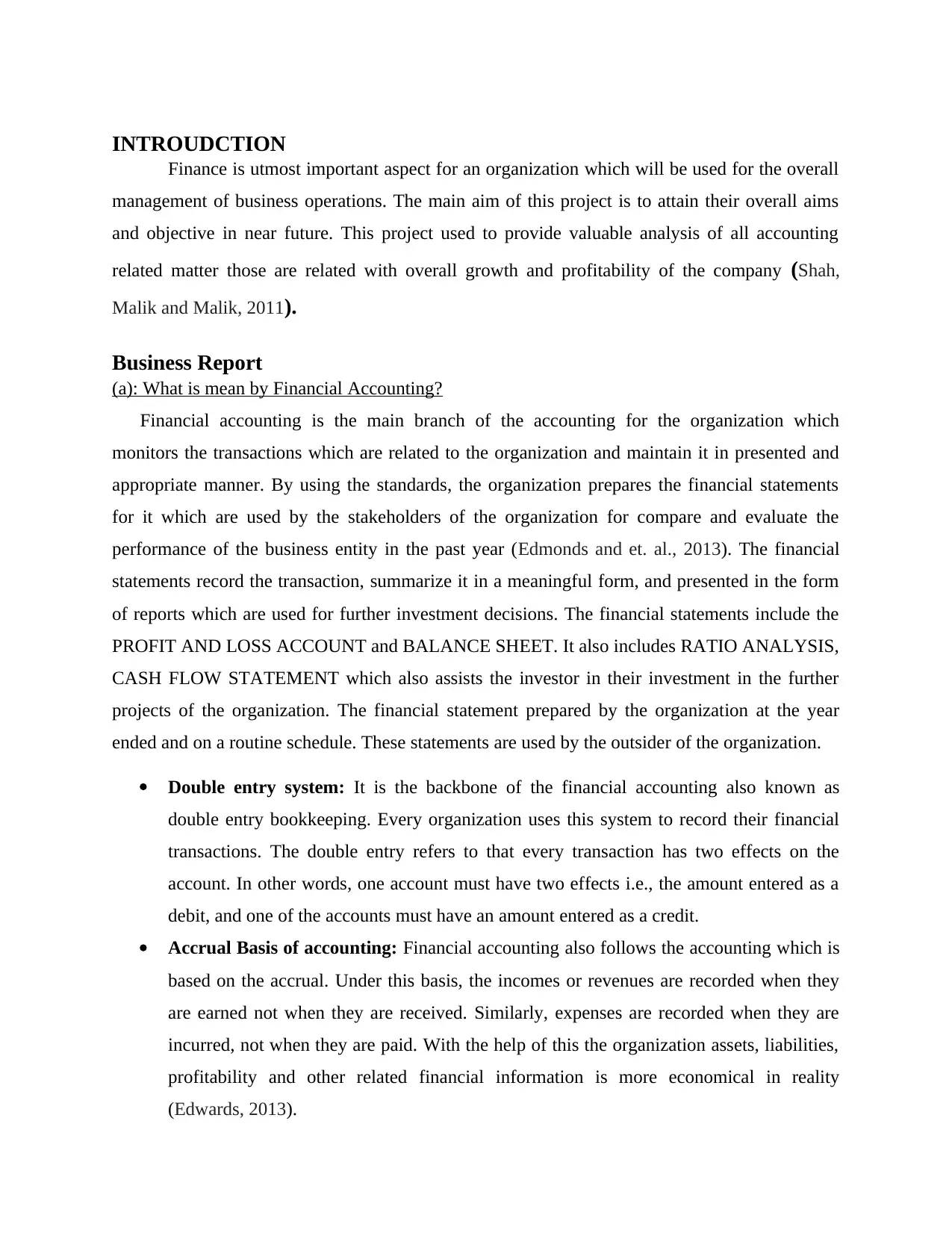
INTROUDCTION
Finance is utmost important aspect for an organization which will be used for the overall
management of business operations. The main aim of this project is to attain their overall aims
and objective in near future. This project used to provide valuable analysis of all accounting
related matter those are related with overall growth and profitability of the company (Shah,
Malik and Malik, 2011).
Business Report
(a): What is mean by Financial Accounting?
Financial accounting is the main branch of the accounting for the organization which
monitors the transactions which are related to the organization and maintain it in presented and
appropriate manner. By using the standards, the organization prepares the financial statements
for it which are used by the stakeholders of the organization for compare and evaluate the
performance of the business entity in the past year (Edmonds and et. al., 2013). The financial
statements record the transaction, summarize it in a meaningful form, and presented in the form
of reports which are used for further investment decisions. The financial statements include the
PROFIT AND LOSS ACCOUNT and BALANCE SHEET. It also includes RATIO ANALYSIS,
CASH FLOW STATEMENT which also assists the investor in their investment in the further
projects of the organization. The financial statement prepared by the organization at the year
ended and on a routine schedule. These statements are used by the outsider of the organization.
Double entry system: It is the backbone of the financial accounting also known as
double entry bookkeeping. Every organization uses this system to record their financial
transactions. The double entry refers to that every transaction has two effects on the
account. In other words, one account must have two effects i.e., the amount entered as a
debit, and one of the accounts must have an amount entered as a credit.
Accrual Basis of accounting: Financial accounting also follows the accounting which is
based on the accrual. Under this basis, the incomes or revenues are recorded when they
are earned not when they are received. Similarly, expenses are recorded when they are
incurred, not when they are paid. With the help of this the organization assets, liabilities,
profitability and other related financial information is more economical in reality
(Edwards, 2013).
Finance is utmost important aspect for an organization which will be used for the overall
management of business operations. The main aim of this project is to attain their overall aims
and objective in near future. This project used to provide valuable analysis of all accounting
related matter those are related with overall growth and profitability of the company (Shah,
Malik and Malik, 2011).
Business Report
(a): What is mean by Financial Accounting?
Financial accounting is the main branch of the accounting for the organization which
monitors the transactions which are related to the organization and maintain it in presented and
appropriate manner. By using the standards, the organization prepares the financial statements
for it which are used by the stakeholders of the organization for compare and evaluate the
performance of the business entity in the past year (Edmonds and et. al., 2013). The financial
statements record the transaction, summarize it in a meaningful form, and presented in the form
of reports which are used for further investment decisions. The financial statements include the
PROFIT AND LOSS ACCOUNT and BALANCE SHEET. It also includes RATIO ANALYSIS,
CASH FLOW STATEMENT which also assists the investor in their investment in the further
projects of the organization. The financial statement prepared by the organization at the year
ended and on a routine schedule. These statements are used by the outsider of the organization.
Double entry system: It is the backbone of the financial accounting also known as
double entry bookkeeping. Every organization uses this system to record their financial
transactions. The double entry refers to that every transaction has two effects on the
account. In other words, one account must have two effects i.e., the amount entered as a
debit, and one of the accounts must have an amount entered as a credit.
Accrual Basis of accounting: Financial accounting also follows the accounting which is
based on the accrual. Under this basis, the incomes or revenues are recorded when they
are earned not when they are received. Similarly, expenses are recorded when they are
incurred, not when they are paid. With the help of this the organization assets, liabilities,
profitability and other related financial information is more economical in reality
(Edwards, 2013).
⊘ This is a preview!⊘
Do you want full access?
Subscribe today to unlock all pages.

Trusted by 1+ million students worldwide
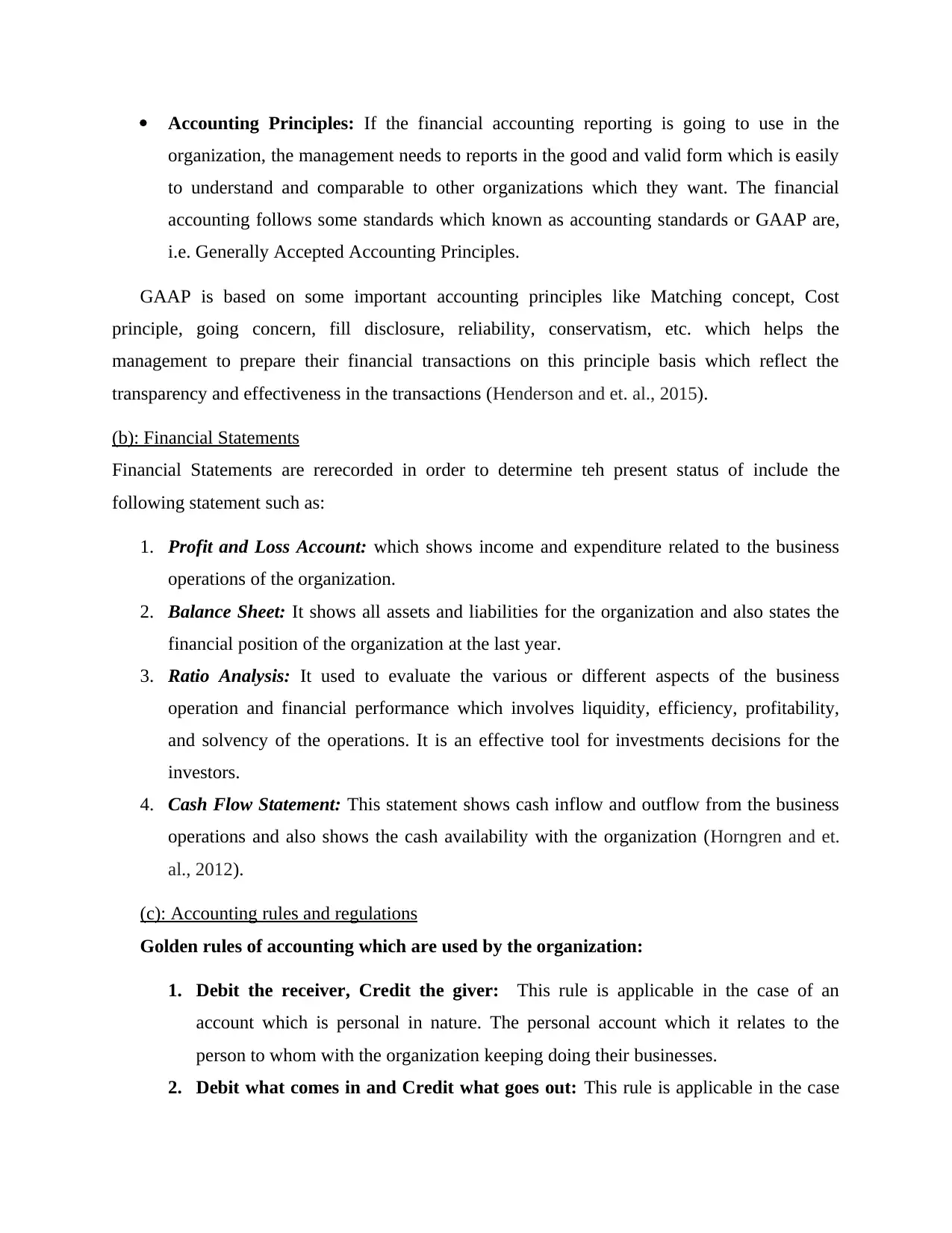
Accounting Principles: If the financial accounting reporting is going to use in the
organization, the management needs to reports in the good and valid form which is easily
to understand and comparable to other organizations which they want. The financial
accounting follows some standards which known as accounting standards or GAAP are,
i.e. Generally Accepted Accounting Principles.
GAAP is based on some important accounting principles like Matching concept, Cost
principle, going concern, fill disclosure, reliability, conservatism, etc. which helps the
management to prepare their financial transactions on this principle basis which reflect the
transparency and effectiveness in the transactions (Henderson and et. al., 2015).
(b): Financial Statements
Financial Statements are rerecorded in order to determine teh present status of include the
following statement such as:
1. Profit and Loss Account: which shows income and expenditure related to the business
operations of the organization.
2. Balance Sheet: It shows all assets and liabilities for the organization and also states the
financial position of the organization at the last year.
3. Ratio Analysis: It used to evaluate the various or different aspects of the business
operation and financial performance which involves liquidity, efficiency, profitability,
and solvency of the operations. It is an effective tool for investments decisions for the
investors.
4. Cash Flow Statement: This statement shows cash inflow and outflow from the business
operations and also shows the cash availability with the organization (Horngren and et.
al., 2012).
(c): Accounting rules and regulations
Golden rules of accounting which are used by the organization:
1. Debit the receiver, Credit the giver: This rule is applicable in the case of an
account which is personal in nature. The personal account which it relates to the
person to whom with the organization keeping doing their businesses.
2. Debit what comes in and Credit what goes out: This rule is applicable in the case
organization, the management needs to reports in the good and valid form which is easily
to understand and comparable to other organizations which they want. The financial
accounting follows some standards which known as accounting standards or GAAP are,
i.e. Generally Accepted Accounting Principles.
GAAP is based on some important accounting principles like Matching concept, Cost
principle, going concern, fill disclosure, reliability, conservatism, etc. which helps the
management to prepare their financial transactions on this principle basis which reflect the
transparency and effectiveness in the transactions (Henderson and et. al., 2015).
(b): Financial Statements
Financial Statements are rerecorded in order to determine teh present status of include the
following statement such as:
1. Profit and Loss Account: which shows income and expenditure related to the business
operations of the organization.
2. Balance Sheet: It shows all assets and liabilities for the organization and also states the
financial position of the organization at the last year.
3. Ratio Analysis: It used to evaluate the various or different aspects of the business
operation and financial performance which involves liquidity, efficiency, profitability,
and solvency of the operations. It is an effective tool for investments decisions for the
investors.
4. Cash Flow Statement: This statement shows cash inflow and outflow from the business
operations and also shows the cash availability with the organization (Horngren and et.
al., 2012).
(c): Accounting rules and regulations
Golden rules of accounting which are used by the organization:
1. Debit the receiver, Credit the giver: This rule is applicable in the case of an
account which is personal in nature. The personal account which it relates to the
person to whom with the organization keeping doing their businesses.
2. Debit what comes in and Credit what goes out: This rule is applicable in the case
Paraphrase This Document
Need a fresh take? Get an instant paraphrase of this document with our AI Paraphraser
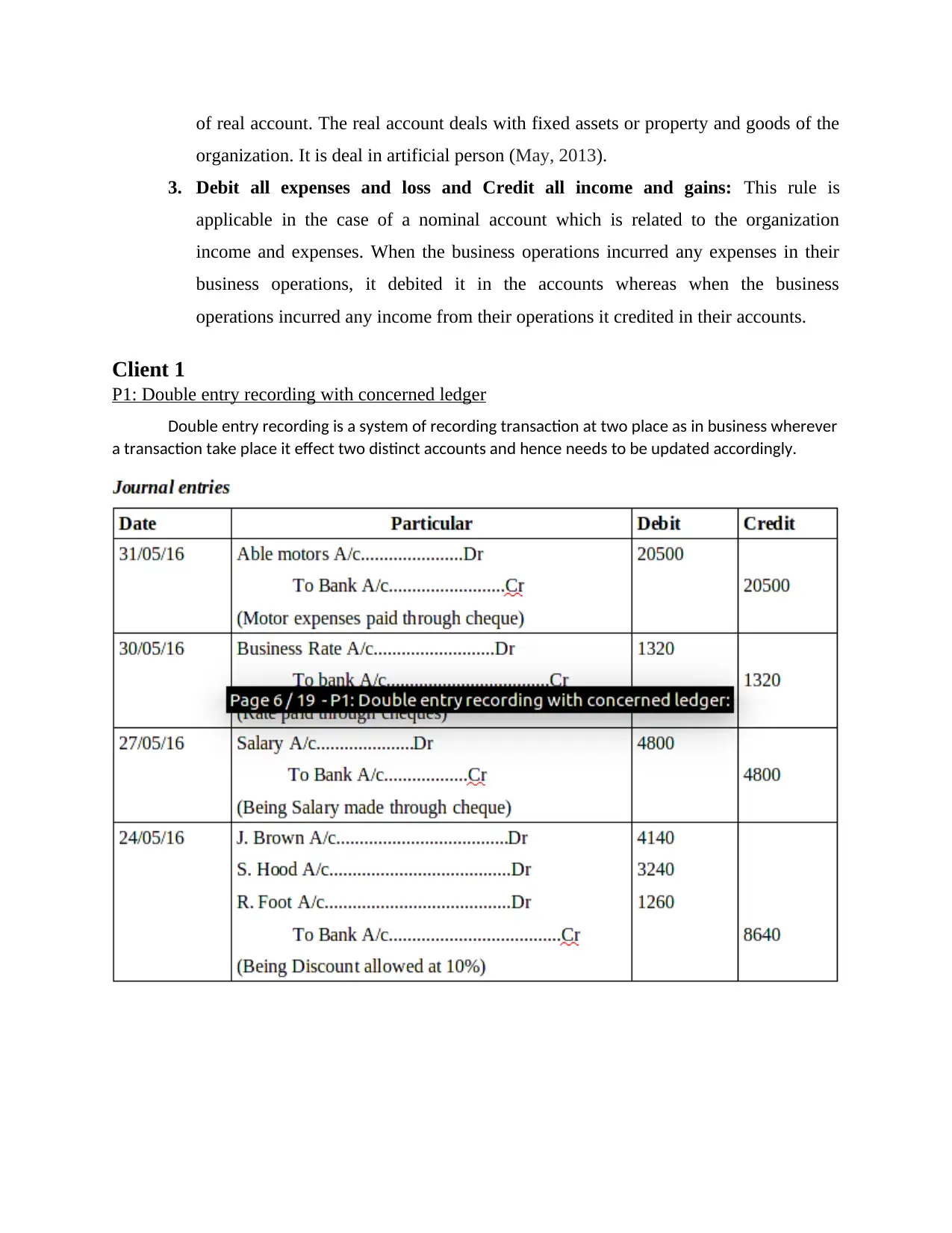
of real account. The real account deals with fixed assets or property and goods of the
organization. It is deal in artificial person (May, 2013).
3. Debit all expenses and loss and Credit all income and gains: This rule is
applicable in the case of a nominal account which is related to the organization
income and expenses. When the business operations incurred any expenses in their
business operations, it debited it in the accounts whereas when the business
operations incurred any income from their operations it credited in their accounts.
Client 1
P1: Double entry recording with concerned ledger
Double entry recording is a system of recording transaction at two place as in business wherever
a transaction take place it effect two distinct accounts and hence needs to be updated accordingly.
organization. It is deal in artificial person (May, 2013).
3. Debit all expenses and loss and Credit all income and gains: This rule is
applicable in the case of a nominal account which is related to the organization
income and expenses. When the business operations incurred any expenses in their
business operations, it debited it in the accounts whereas when the business
operations incurred any income from their operations it credited in their accounts.
Client 1
P1: Double entry recording with concerned ledger
Double entry recording is a system of recording transaction at two place as in business wherever
a transaction take place it effect two distinct accounts and hence needs to be updated accordingly.
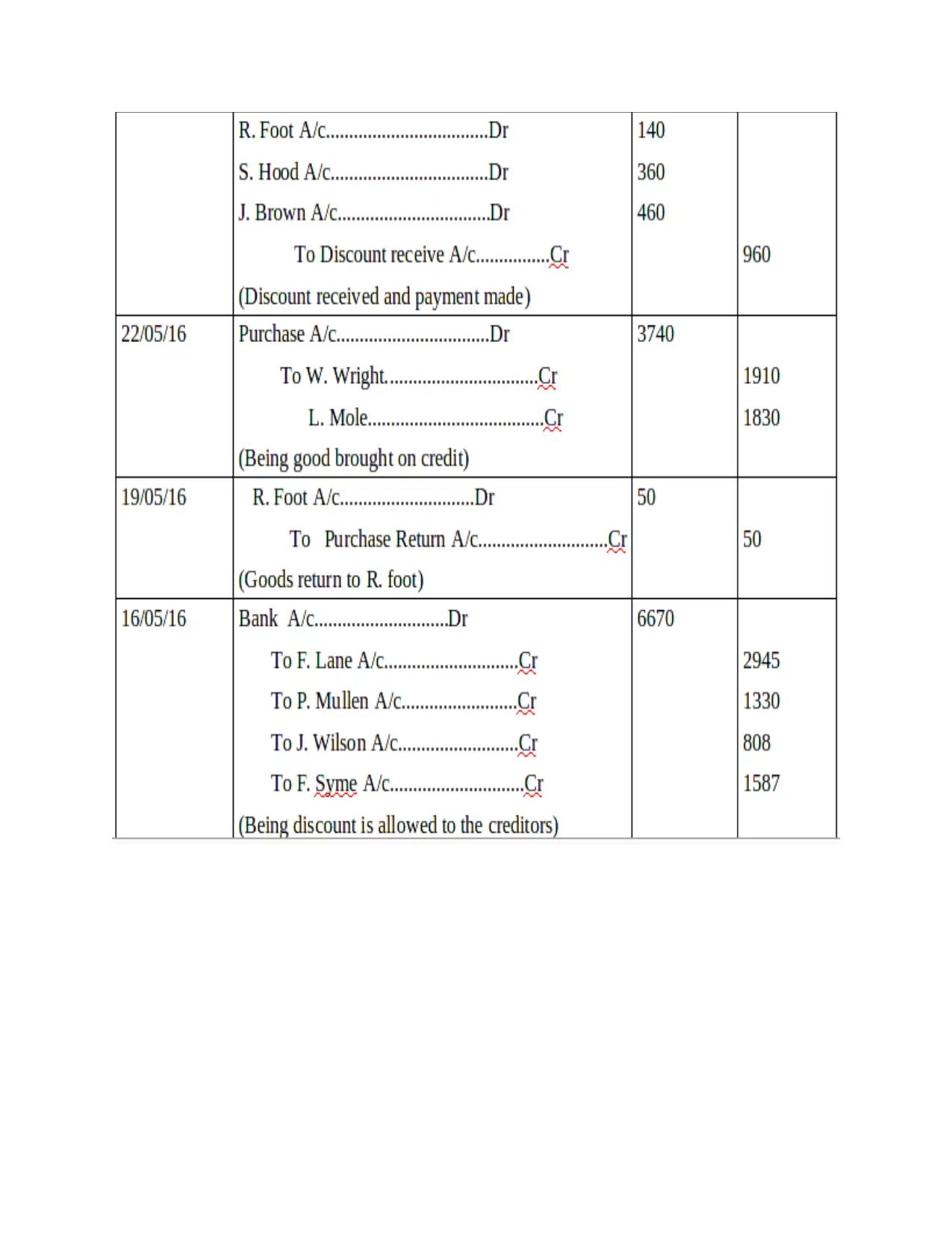
⊘ This is a preview!⊘
Do you want full access?
Subscribe today to unlock all pages.

Trusted by 1+ million students worldwide
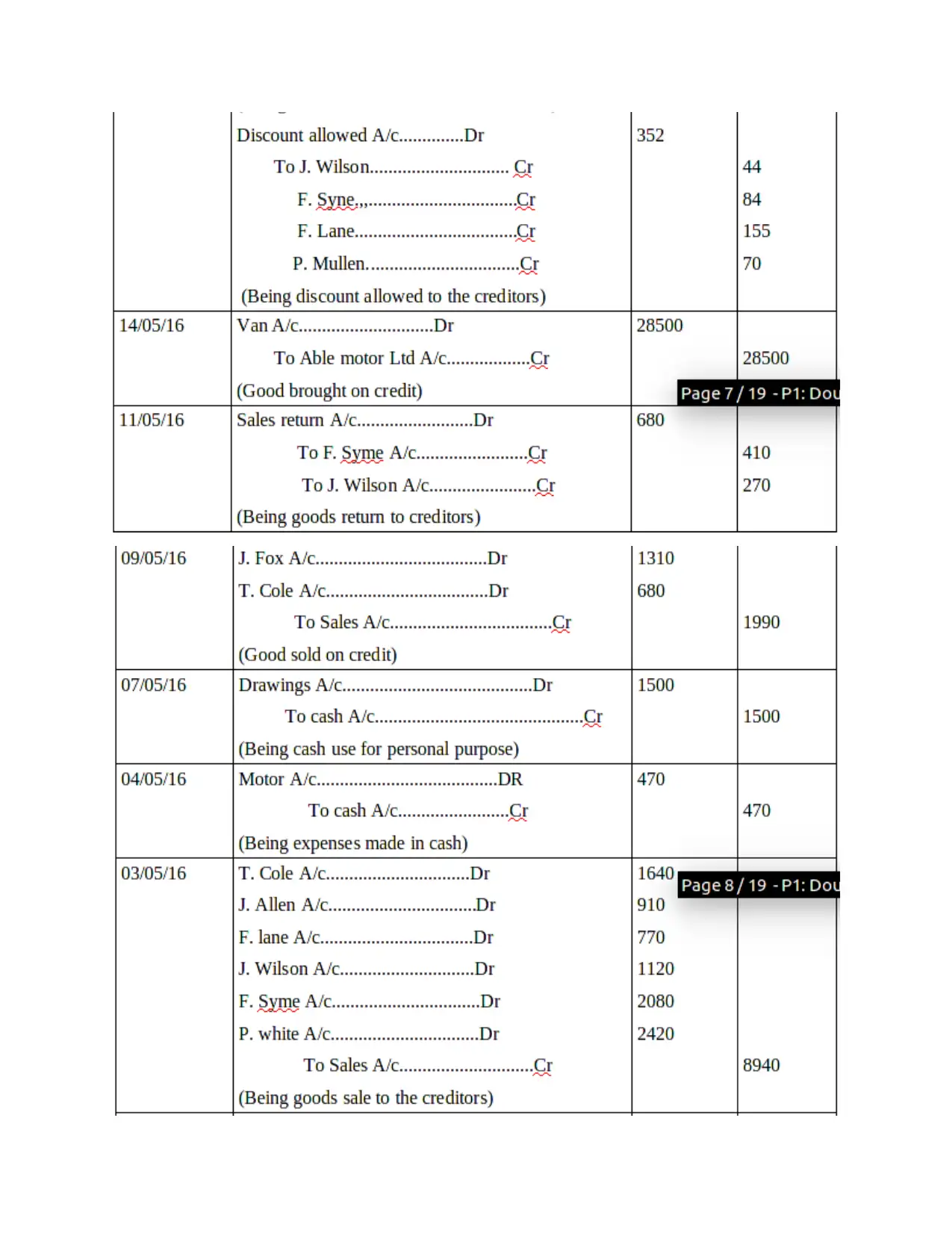
Paraphrase This Document
Need a fresh take? Get an instant paraphrase of this document with our AI Paraphraser
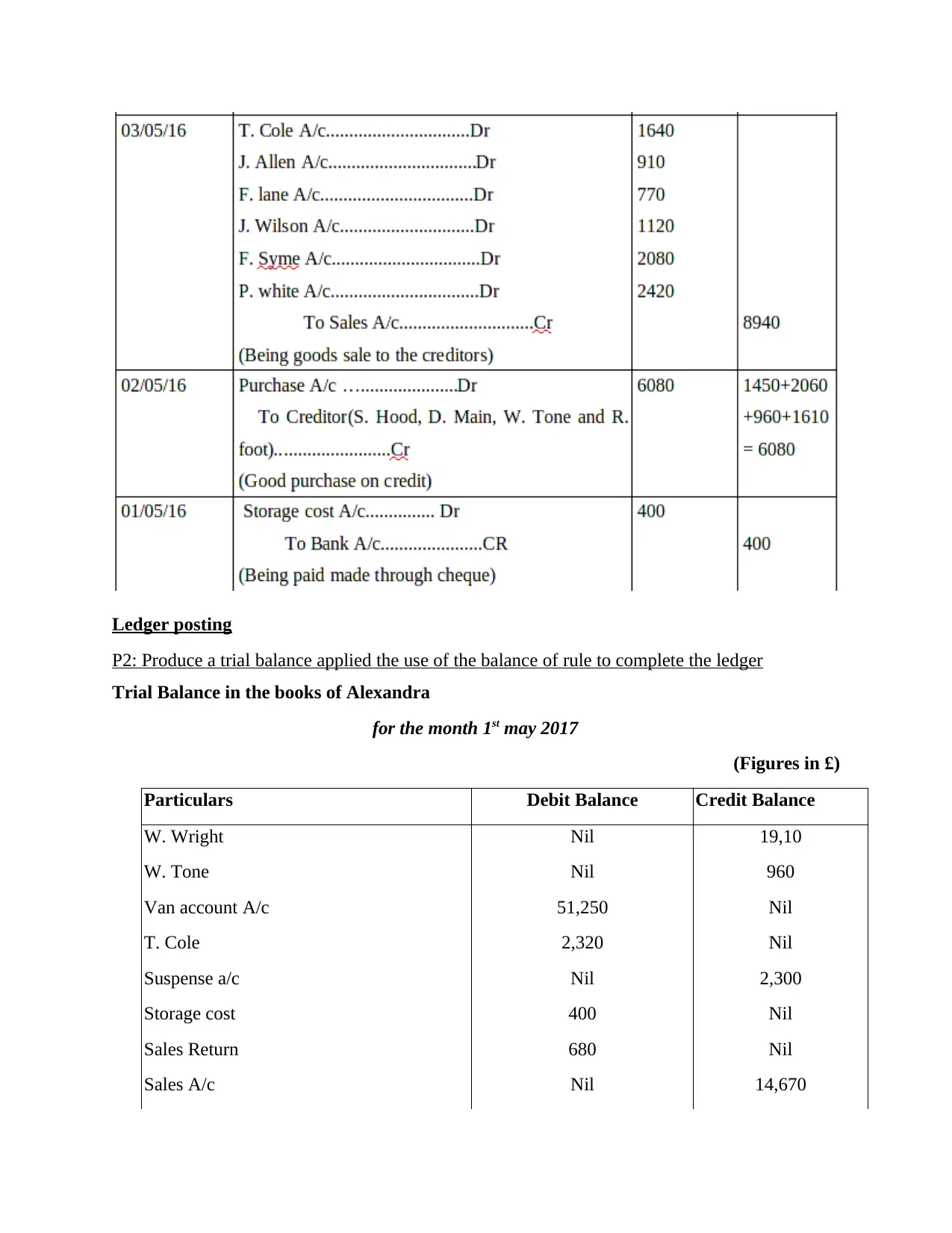
Ledger posting
P2: Produce a trial balance applied the use of the balance of rule to complete the ledger
Trial Balance in the books of Alexandra
for the month 1st may 2017
(Figures in £)
Particulars Debit Balance Credit Balance
W. Wright Nil 19,10
W. Tone Nil 960
Van account A/c 51,250 Nil
T. Cole 2,320 Nil
Suspense a/c Nil 2,300
Storage cost 400 Nil
Sales Return 680 Nil
Sales A/c Nil 14,670
P2: Produce a trial balance applied the use of the balance of rule to complete the ledger
Trial Balance in the books of Alexandra
for the month 1st may 2017
(Figures in £)
Particulars Debit Balance Credit Balance
W. Wright Nil 19,10
W. Tone Nil 960
Van account A/c 51,250 Nil
T. Cole 2,320 Nil
Suspense a/c Nil 2,300
Storage cost 400 Nil
Sales Return 680 Nil
Sales A/c Nil 14,670
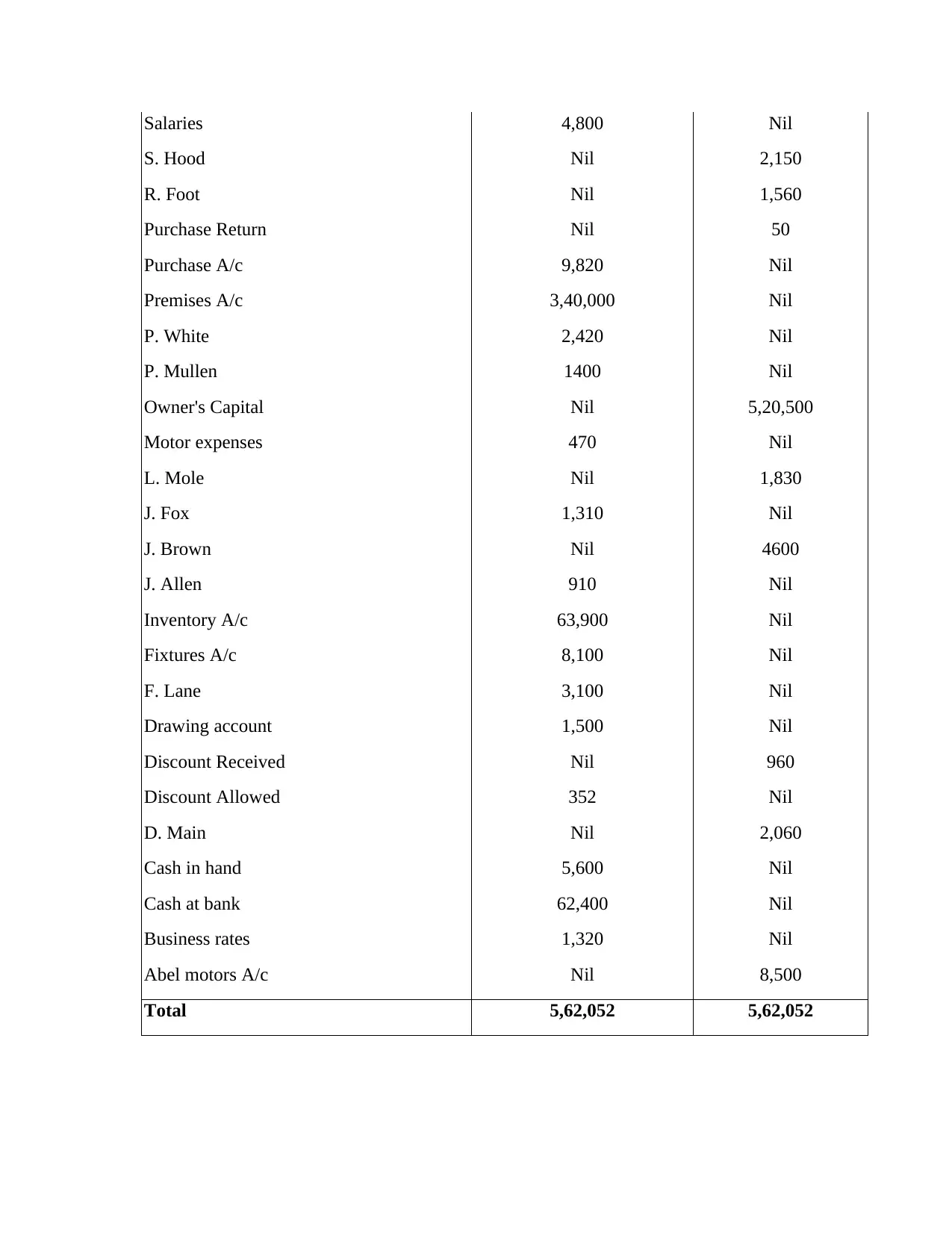
Salaries 4,800 Nil
S. Hood Nil 2,150
R. Foot Nil 1,560
Purchase Return Nil 50
Purchase A/c 9,820 Nil
Premises A/c 3,40,000 Nil
P. White 2,420 Nil
P. Mullen 1400 Nil
Owner's Capital Nil 5,20,500
Motor expenses 470 Nil
L. Mole Nil 1,830
J. Fox 1,310 Nil
J. Brown Nil 4600
J. Allen 910 Nil
Inventory A/c 63,900 Nil
Fixtures A/c 8,100 Nil
F. Lane 3,100 Nil
Drawing account 1,500 Nil
Discount Received Nil 960
Discount Allowed 352 Nil
D. Main Nil 2,060
Cash in hand 5,600 Nil
Cash at bank 62,400 Nil
Business rates 1,320 Nil
Abel motors A/c Nil 8,500
Total 5,62,052 5,62,052
S. Hood Nil 2,150
R. Foot Nil 1,560
Purchase Return Nil 50
Purchase A/c 9,820 Nil
Premises A/c 3,40,000 Nil
P. White 2,420 Nil
P. Mullen 1400 Nil
Owner's Capital Nil 5,20,500
Motor expenses 470 Nil
L. Mole Nil 1,830
J. Fox 1,310 Nil
J. Brown Nil 4600
J. Allen 910 Nil
Inventory A/c 63,900 Nil
Fixtures A/c 8,100 Nil
F. Lane 3,100 Nil
Drawing account 1,500 Nil
Discount Received Nil 960
Discount Allowed 352 Nil
D. Main Nil 2,060
Cash in hand 5,600 Nil
Cash at bank 62,400 Nil
Business rates 1,320 Nil
Abel motors A/c Nil 8,500
Total 5,62,052 5,62,052
⊘ This is a preview!⊘
Do you want full access?
Subscribe today to unlock all pages.

Trusted by 1+ million students worldwide
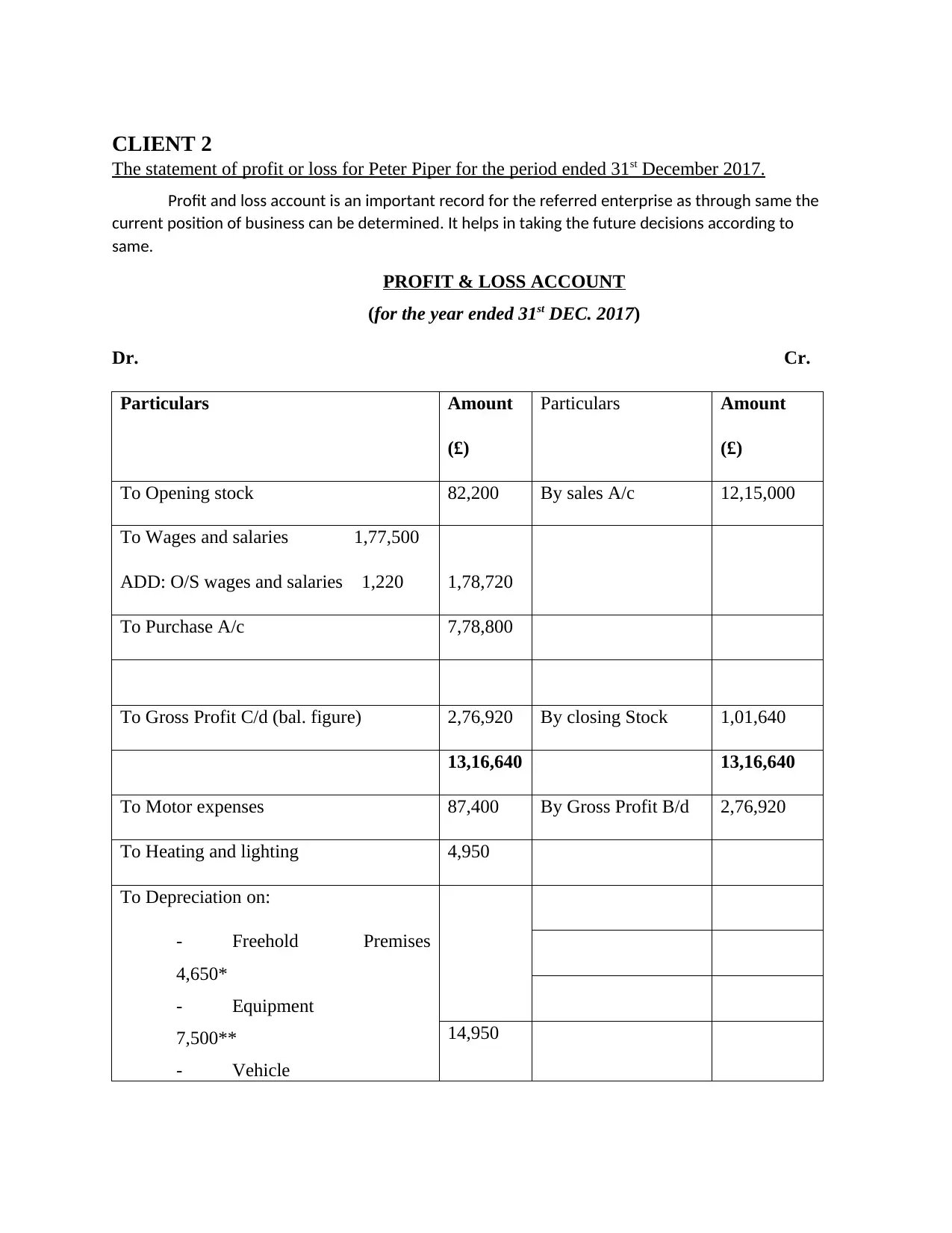
CLIENT 2
The statement of profit or loss for Peter Piper for the period ended 31st December 2017.
Profit and loss account is an important record for the referred enterprise as through same the
current position of business can be determined. It helps in taking the future decisions according to
same.
PROFIT & LOSS ACCOUNT
(for the year ended 31st DEC. 2017)
Dr. Cr.
Particulars Amount
(£)
Particulars Amount
(£)
To Opening stock 82,200 By sales A/c 12,15,000
To Wages and salaries 1,77,500
ADD: O/S wages and salaries 1,220 1,78,720
To Purchase A/c 7,78,800
To Gross Profit C/d (bal. figure) 2,76,920 By closing Stock 1,01,640
13,16,640 13,16,640
To Motor expenses 87,400 By Gross Profit B/d 2,76,920
To Heating and lighting 4,950
To Depreciation on:
- Freehold Premises
4,650*
- Equipment
7,500**
- Vehicle
14,950
The statement of profit or loss for Peter Piper for the period ended 31st December 2017.
Profit and loss account is an important record for the referred enterprise as through same the
current position of business can be determined. It helps in taking the future decisions according to
same.
PROFIT & LOSS ACCOUNT
(for the year ended 31st DEC. 2017)
Dr. Cr.
Particulars Amount
(£)
Particulars Amount
(£)
To Opening stock 82,200 By sales A/c 12,15,000
To Wages and salaries 1,77,500
ADD: O/S wages and salaries 1,220 1,78,720
To Purchase A/c 7,78,800
To Gross Profit C/d (bal. figure) 2,76,920 By closing Stock 1,01,640
13,16,640 13,16,640
To Motor expenses 87,400 By Gross Profit B/d 2,76,920
To Heating and lighting 4,950
To Depreciation on:
- Freehold Premises
4,650*
- Equipment
7,500**
- Vehicle
14,950
Paraphrase This Document
Need a fresh take? Get an instant paraphrase of this document with our AI Paraphraser
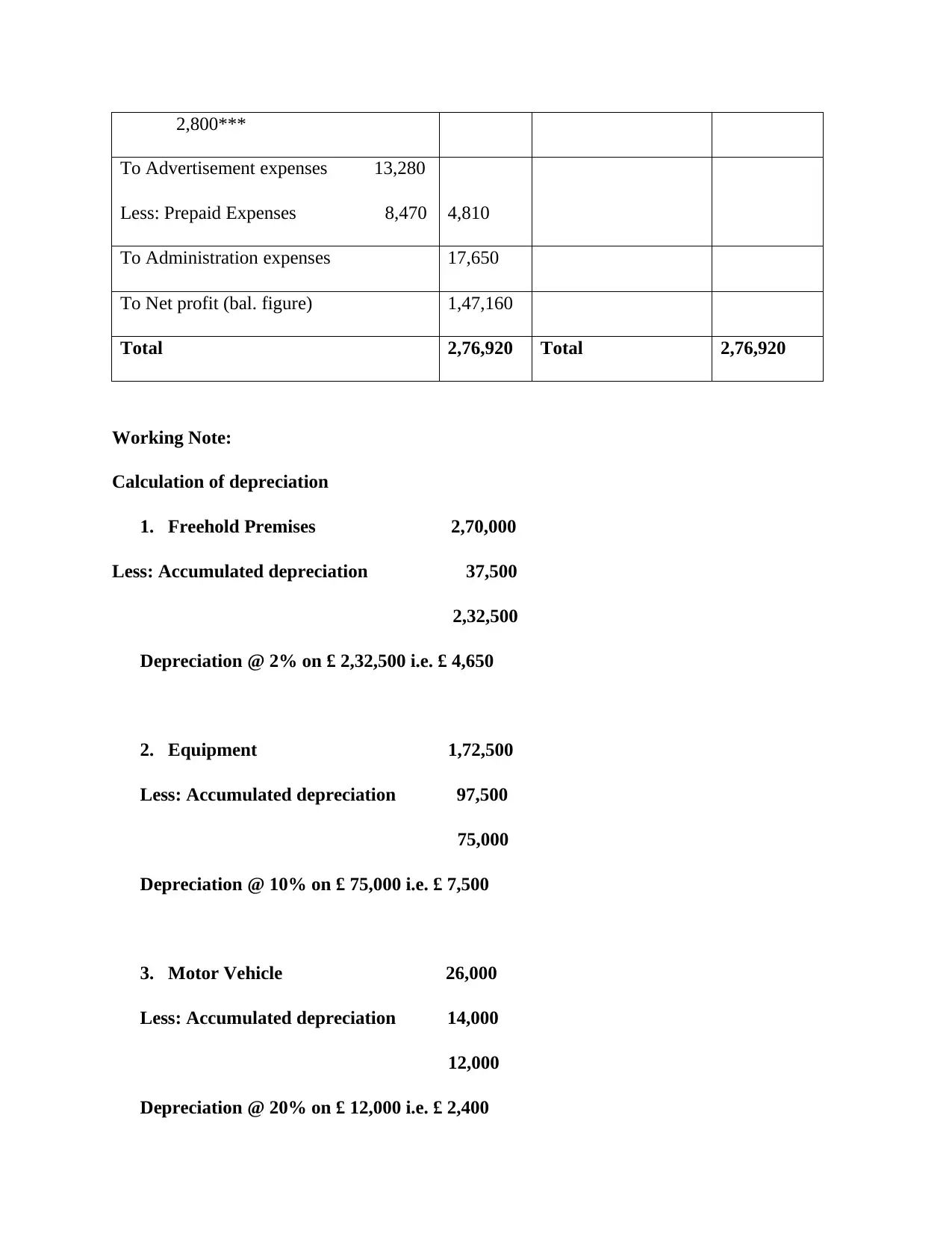
2,800***
To Advertisement expenses 13,280
Less: Prepaid Expenses 8,470 4,810
To Administration expenses 17,650
To Net profit (bal. figure) 1,47,160
Total 2,76,920 Total 2,76,920
Working Note:
Calculation of depreciation
1. Freehold Premises 2,70,000
Less: Accumulated depreciation 37,500
2,32,500
Depreciation @ 2% on £ 2,32,500 i.e. £ 4,650
2. Equipment 1,72,500
Less: Accumulated depreciation 97,500
75,000
Depreciation @ 10% on £ 75,000 i.e. £ 7,500
3. Motor Vehicle 26,000
Less: Accumulated depreciation 14,000
12,000
Depreciation @ 20% on £ 12,000 i.e. £ 2,400
To Advertisement expenses 13,280
Less: Prepaid Expenses 8,470 4,810
To Administration expenses 17,650
To Net profit (bal. figure) 1,47,160
Total 2,76,920 Total 2,76,920
Working Note:
Calculation of depreciation
1. Freehold Premises 2,70,000
Less: Accumulated depreciation 37,500
2,32,500
Depreciation @ 2% on £ 2,32,500 i.e. £ 4,650
2. Equipment 1,72,500
Less: Accumulated depreciation 97,500
75,000
Depreciation @ 10% on £ 75,000 i.e. £ 7,500
3. Motor Vehicle 26,000
Less: Accumulated depreciation 14,000
12,000
Depreciation @ 20% on £ 12,000 i.e. £ 2,400
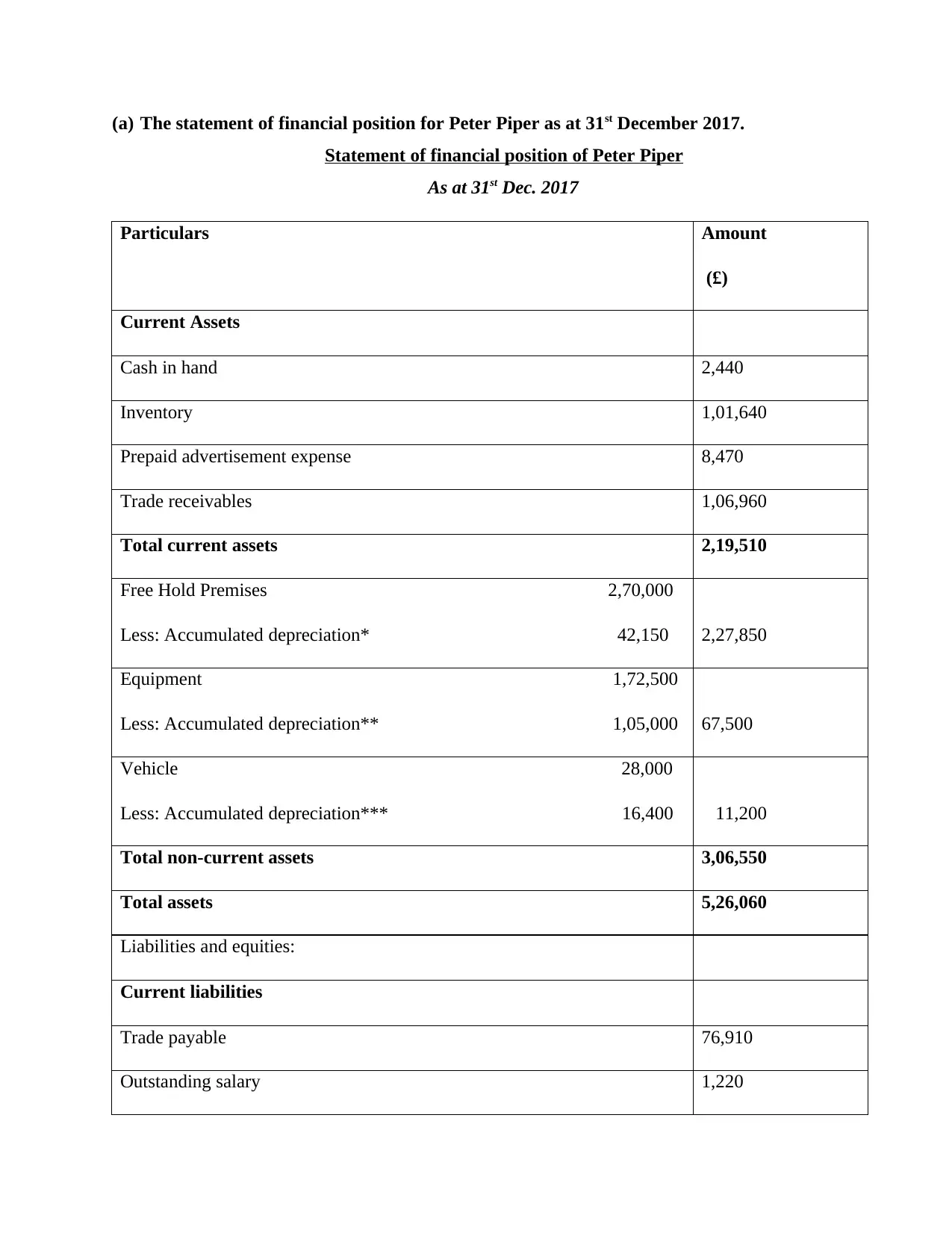
(a) The statement of financial position for Peter Piper as at 31st December 2017.
Statement of financial position of Peter Piper
As at 31st Dec. 2017
Particulars Amount
(£)
Current Assets
Cash in hand 2,440
Inventory 1,01,640
Prepaid advertisement expense 8,470
Trade receivables 1,06,960
Total current assets 2,19,510
Free Hold Premises 2,70,000
Less: Accumulated depreciation* 42,150 2,27,850
Equipment 1,72,500
Less: Accumulated depreciation** 1,05,000 67,500
Vehicle 28,000
Less: Accumulated depreciation*** 16,400 11,200
Total non-current assets 3,06,550
Total assets 5,26,060
Liabilities and equities:
Current liabilities
Trade payable 76,910
Outstanding salary 1,220
Statement of financial position of Peter Piper
As at 31st Dec. 2017
Particulars Amount
(£)
Current Assets
Cash in hand 2,440
Inventory 1,01,640
Prepaid advertisement expense 8,470
Trade receivables 1,06,960
Total current assets 2,19,510
Free Hold Premises 2,70,000
Less: Accumulated depreciation* 42,150 2,27,850
Equipment 1,72,500
Less: Accumulated depreciation** 1,05,000 67,500
Vehicle 28,000
Less: Accumulated depreciation*** 16,400 11,200
Total non-current assets 3,06,550
Total assets 5,26,060
Liabilities and equities:
Current liabilities
Trade payable 76,910
Outstanding salary 1,220
⊘ This is a preview!⊘
Do you want full access?
Subscribe today to unlock all pages.

Trusted by 1+ million students worldwide
1 out of 23
Related Documents
Your All-in-One AI-Powered Toolkit for Academic Success.
+13062052269
info@desklib.com
Available 24*7 on WhatsApp / Email
![[object Object]](/_next/static/media/star-bottom.7253800d.svg)
Unlock your academic potential
Copyright © 2020–2025 A2Z Services. All Rights Reserved. Developed and managed by ZUCOL.





